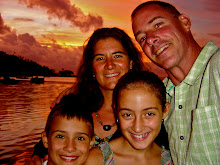Today we took a river taxi and a ferryboat to Wat Arun, the Temple of the Dawn, which is on the west shore of the Chao Praya River in the heart of Bangkok. The river is super dirty. The water was brown and there was quite a bit of litter. There were little fish jumping all the time though so the water supports at least some life. There were all sorts of boats going along, including long tails, river taxis, tourist boats, hotel boats, barges and tug boats. The shoreline was very much developed, with towers, bridges, hotels, apartments, markets and houses’ and docks. The Chao Praya River forms pretty much the center of Bangkok so there were also many temples and royal buildings including the Grand Palace, where Thai royalty lived at one time.
The Chao Praya River
Our river taxi ride was very inexpensive. It cost us 13 Thai baht per person or just under $1.60 US to take all of us way up the river. The boat was much smaller than the Bainbridge Island ferry. It had no "facilities", no galley, no games, no place for cars and only one deck. All it had were seats, a driver, a propeller and lots of people. It was so crowded that there was not one seat left by the time we got on board. We just had to stand and hold onto the railings so we didn’t fall over.
The boat made many stops along the river. The captain would back the stern of the boat into each dock so people could get on and off. A member of the crew at the back of the boat would use a whistle to help the captain dock the boat and tell him when it was okay to leave. He used many different types of whistles so the ride was pretty loud. After a number of stops we got off the taxi on the east shore of the river and climbed onto a ferry to take us across the river to Wat Arun, the Temple of the Dawn.
Wat Arun - The Temple of the Dawn
Most Thais are Buddhists. They adhere to the Theravada School of Buddhism, which recognizes the Buddha not as a God but as a great teacher who worked hard and found Enlightenment or peace within Himself. Buddhists study the Buddha’s teachings so they can try and be like him. Visiting a temple such as Wat Arun is one way of showing respect to The Buddha and his teachings. There are some 400 Buddhist temples in Bangkok alone.
Wat Arun is really big and covered with broken pottery and cowrie shells in different shapes like flowers. A lot of the pottery came from Chinese traders who used the porcelain as ballast to help steady their ships. The temple stairs were really, really steep. They were very tall and very narrow, seemingly made for people with very small feet. Monks with shaven heads were scattered all over the expansive grounds of the temple. There is a chapel where they worship Buddha and study his teachings. There were also many statues of different animals of the Chinese zodiac, including dogs, horses, boars, tigers and goats. We saw stray cats all the place. Some looked very sick. It was kind of sad. Pigeons and other birds also landed on the buildings, including on the image of Buddha riding on a three-headed elephant at top of the main spire.
Wat Arun
We walked around the temple for about an hour and then we took the ferry back to the other side to visit Wat Po, the Temple of the Reclining Buddha. The Reclining Buddha is 46 meters long and 16 meters high. He is covered in gold leaf and is leaning on a giant pillow coated in gold and tile work. It is most amazing when you walk past his huge feet inlaid with intricate designs in mother-of pearl.
Wat Po's Reclining Buddha
The walls of the temple were covered with paintings or designs in black and gold lacquer. There was also a row of 108 buckets where you could drop Thai baht coins to give you good luck. 108 is a sacred number in Eastern religions and traditions and is often represented in Buddhist and Hindu temples. For instance, the snake temple we visited in Labasa, Fiji last fall had 108 steps, which followers could use to perform prayer rituals. There are also 108 stitches in a baseball. Hmmm. (Source: Wikipedia.)
Wat P0's 108 "lucky" pots
Like with most temples in Bangkok, you had to take your shoes off before you entered Wat Po, to show respect to the Buddha. Many people – tourists, monks, school kids, tour guides and Thais -- come to see and worship. The temple was part of a compound with many other highly decorated buildings. Most had colorful tile roof shingles and mirrors and ceramics on the eaves and gables. There were also small gardens and rockeries scattered throughout the complex. There is even a tiny waterfall outside the temple.
After leaving Wat Po we were all very thirsty because we didn’t have any water and it felt like it was 200 degrees Celsius. (I could not live here if there was no air conditioning! Sometimes we go into a store or restaurant just to cool off.) Finally we got some water and climbed aboard one more river taxi. After we got off, we took the BTS (Bangkok Transit System) to Siam station and had lunch.
Visiting the temples was a hot, crowded and smelly ordeal but it was a good trip. Something that surprised me was how big the temples were. The cowries and porcelain on Wat Arun and the Reclining Buddha covered in gold leaf were very impressive. I’m kind of done with temples for a while though.






No comments:
Post a Comment